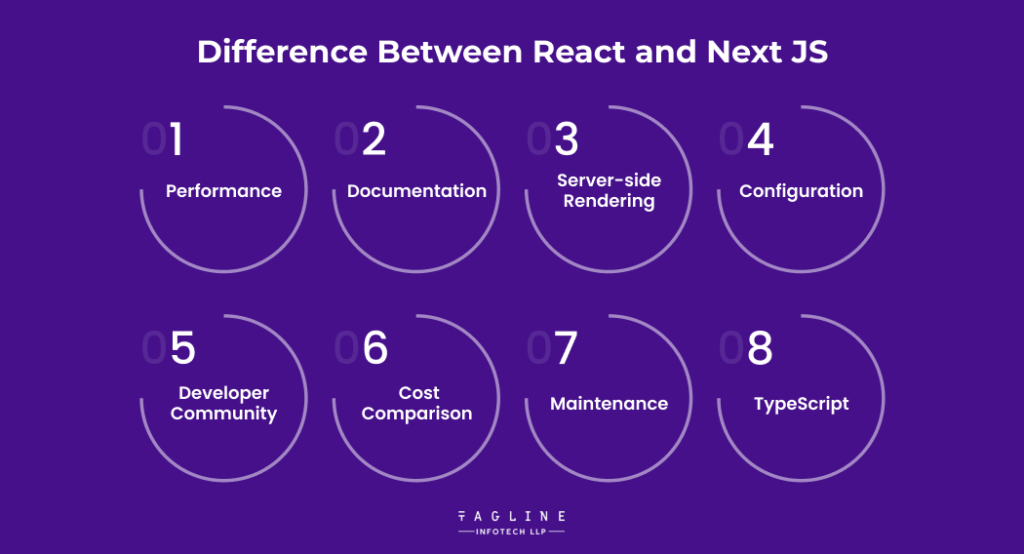A List of The 25 Best Ruby on...
May 8, 2024
Home >> Web Development >> Next.JS vs React: What is the best front-end framework for 2024?

Quick Summary
Not only is Next.JS built on top of React, but it’s a more straightforward development environment. Even developers starting with front-end programming may quickly pick it up due to the minimal learning curve. Building a project with Next JS is a unique experience compared to building with React. React is just a JavaScript library, whereas Next.JS is a React framework. This distinction should be noticed. This is how Next.JS and React are compared.
The JavaScript framework can develop static web pages and online apps quickly and easily. It is an open-source project. It is based on Node.js and Babel and provides React integration for single-page application development. The server side improves convenience and usability.
Next JS is a JavaScript framework that enables developers to use React to construct user-friendly and blazingly fast static webpages and web applications. NextJS is a lightweight, open-source web development framework explicitly made for use with React projects. It enables server-side renderer construction for developers.
As massive web apps are being developed, React has become one of the most widely used and well-known front-end libraries. Facebook created the JavaScript framework known as React. Even though it is not a language, React is a popular library in web development.
The library first appeared in May 2013 and is now one of the most popular front-end libraries for web development. With the help of this adaptable, open-source toolkit, developers can quickly, simply, and scalable construct frontend interfaces for single- or multi-page web applications. Furthermore, it aligns with the functional programming paradigm and the reactive approach.
One of the most well-known front-end libraries is called React, which Facebook created. It makes it possible for developers to create reusable UI elements. React is an easy-to-use front-end library that offers a range of valuable capabilities for encompassing routing and state management patterns, in addition to Redux and other libraries.

There are various benefits and drawbacks to using Next JS and React for React/JavaScript projects, should you choose to use them for your development project. However, these fundamental front-end development tools offer a smooth and enjoyable online development experience. Nevertheless, although they are all easy to learn, each has a different learning curve.
One of the main reasons for the high-speed Next.js applications is that they leverage server-side rendering and static destinations. They are practical due to their many performance-enhancing features, like Image Optimization.
This means that if you choose to utilize Next.js for your project, you can benefit from code-splitting and automatic server rendering, both of which will improve the efficiency of your work. SSR is also important for enhancing an application’s overall performance.
Some subjects can only be covered in a different context even if we’re talking about React. It does allow for client-side rendering. However, more is needed to build high-performance apps with this feature.
The documentation section is the most significant consideration when deciding how React and Next JS differ. Knowing which libraries to use, how to use tools, and much more can all be significantly aided by having access to excellent documentation while creating any kind of project.
However, online resources such as articles, tutorials, and documentation for Next.js and React are easily accessible. Next.js offers a compilation of “learn-by-doing” lessons. These tutorials walk you through building components, developing them, integrating them, and providing help, among other elements of Next JS.
Conversely, React offers a similar style and a few learning exercises covering the essentials.
If you want to make pages for your Next.js project, you’ll need to connect to the necessary header component and put them in the pages folder. On the other hand, you must first create a segment and then input it into the router to generate pages for the React project.
As a result, you can write less code, and your development process will be more simplified.
One of the best methods to deal with React is to use the Create React app, another choice. You can utilize the Create React App method to take advantage early when developing a Single Page Application (SPA). It’s crucial to remember that front-end assembly is handled by the Create React App when comparing ReactJS and NextJS. Thanks to this, you may use it with any server, including Node.
It is noteworthy that Next.JS facilitates Server-side Rendering (SSR), another feature. It gathers information and executes each request when you need to give a different view to several users.
React does not allow server-side rendering by default, although it is a functionality that can be enabled. You will have to work more to integrate SSR with the server and configuration of your choosing. Furthermore, there’s a chance that the developers won’t support this in later versions.
Another distinction between Next.JS and React is that you should consider their settings. React is not very helpful when it comes to configuration. Unless you disconnect from the standard Create React App, you won’t be able to change any of the configurations. You must use what has already been set up or posted in the CRA’s read scripts.
On the other hand, everything may be fully configured with Next.JS.
In this fiercely competitive business, the framework or library you select will have the support of its developer community to help you solve any issues that may arise. React has a fantastic developer community at its disposal. These developers are always coming up with new ways to solve problems, such as blogs, videos, tutorials, and other resources. Additionally, you can use Stack Overflow to learn about the React documentation and the active members.
It includes less traditional workouts and more GitHub talks, so that’s something to consider when considering Next.JS. In the world of open-source software, the developers are reachable and actively involved.
In actuality, the developer community benefits greatly from both Next.JS and React.
React and Next.JS are also left off of the list of the most profitable developments. Furthermore, they are both open-source projects. This makes the cost of creating an application that is built on top of these technologies affordable.
Regarding this specific circumstance, the CRAs of Next.JS and React.js are somewhat opinionated. Not only are they well-maintained, but they also regularly release software updates. All you need to do now is keep up with the most recent modifications.
Next.JS provides support for TypeScript. Additionally, customizations made using the touch tsconfig.json file are supported. On the other hand, React supports TypeScript and comes with a template called npx create-reach-app my-app for CRA projects.
Because React is so much more popular than Next.JS, we can confidently say it is the winner in this comparison between seasoned developers known as React and Next.JS. Finding React developers to work on your project is also not complicated.
Ready to Take Your Front-End Development to the Next Level?
Hire developers from us to build high performance Web Applications.
React is a fantastic option for web applications that are hidden behind a login wall or otherwise do not require search engines to scan them. Utilizing React, you can create:
It’s advised that you use Next.JS for any publicly available website, one that you hope receives a lot of new visitors, and one that you want Google to drive your way through searches. The following scenarios are where Next.js excels:
“Frontend vs Backend Development: A Comprehensive Guide for 2024 “
– Also Read Article
The question that is currently of the utmost importance is: which one should you use? Both of these frameworks are powerful, and the one that you should pick is primarily determined by the use case that you have.
When you are developing complex user interfaces or interactive single-page applications that are not available to the general public or, if they are, you do not care about ranking well in Google for, React is the superior choice. It gives you a great deal of control over rendering and the state of components, and it provides a method that is both flexible and efficient for managing user interface components.
Next.JS, built on React, should be your go-to framework for content-focused, public-facing websites like blogs or e-commerce sites. Search engine optimization (SEO) and initial loading speed are two of the most important factors to consider when developing a website.
The front-end development tools React.js and Next.JS can produce powerful results. In conclusion, React is a beneficial tool for developing user interfaces that are both dynamic and interactive, whereas Next.JS is utilized on top of React to extend its capabilities by providing server-side rendering for improved speed optimization.
In conclusion, Next.js and React are both potent front-end frameworks that have grown in recognition among web developers. Connect with a web development company to get a highly functional website for your business. The fact that Next.js has extra capabilities like server-side rendering, automated code splitting, and improved speed makes it a wonderful option for projects that need to be more useful and performant. React, on the other hand, is a more compact library that focuses on developing user interfaces and is frequently used to construct single-page web applications and mobile apps.
The exact needs of your project will determine whether to use Next.js or React. Next.js can be a better choice if you want greater speed and server-side rendering. React could be the best option if you’re focused on creating user interfaces and need a more simplified toolbox.
Next.js is built on top of React.js and includes server-side rendering and other optimizations, making it potentially faster in terms of initial page load and SEO performance compared to a basic React.js application.
Next.js is not the official React framework. React is developed and maintained by Facebook. Next.js is a popular framework for React used to build server-rendered React applications.
Next.js is a powerful framework that extends React to provide additional features and optimizations for building server-rendered applications. Its default support for server-side rendering, code splitting, and static site generation makes it a popular choice for developers looking to create fast and SEO-friendly web applications.

Digital Valley, 423, Apple Square, beside Lajamni Chowk, Mota Varachha, Surat, Gujarat 394101
+91 9913 808 2851133 Sampley Ln Leander, Texas, 78641
52 Godalming Avenue, wallington, London - SM6 8NW